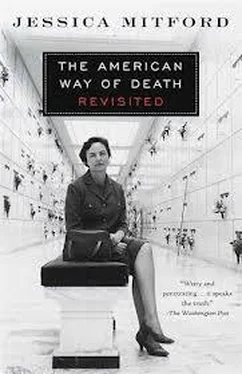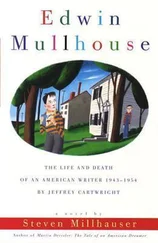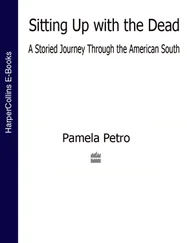There are people, however, who know their own minds perfectly well and who approach the purchase of a funeral much as they would any other transaction. They are, by the nature of things, very much in the minority. Most frequently they are not in the immediate family of the deceased but are friends or representatives of the family. Their experiences are interesting because to some extent they throw into relief the irrational quality of the funeral transaction.
In 1961 Mr. Rufus Rhoades, a retired manufacturer of San Rafael, California, was charged with arranging for the cremation of a ninety-two-year-old friend who died in a rest home. He telephoned the crematorium and was quoted the price of $75 for cremation, plus $15 for shipping the ashes to Santa Monica, where his friend’s family had cemetery space. He suggested hiring an ambulance to pick up the body, but this idea was quickly vetoed by the crematorium. He was told that he would have to deal through an undertaker, that the body could not be touched by anyone but a licensed funeral director, that a “container” would have to be provided. This he was unaware of; and no wonder, for these were “regulations” of the crematorium, not requirements of California law.
Mr. Rhoades looked in the San Rafael telephone directory and found five funeral establishments listed. He picked one at random, called, and was told that under no circumstances could price be discussed over the telephone, as it was “too private a matter”; that he should come down to the funeral home. There he found that the cheapest price, including “a low-priced casket and the complete services,” was $480. Mr. Rhoades protested that he did not want the complete services, that there was to be no embalming, that he did not want to see the coffin. He merely wanted the body removed from the rest home and taken to the crematorium, some five miles away. Balking at the $480, Mr. Rhoades returned home and telephoned the other four funeral establishments. The lowest quotation he could obtain was $250.
Not unnaturally, Mr. Rhoades felt that he had paid a fee of $50 a mile to have his friend’s body moved from the rest home to the crematorium. The undertaker no doubt felt, for his part, that he had furnished a service at well below his “break-even” point, or, in his own terminology, “below the cost at which we are fully compensated.” [3]
The point of view of the funeral director must here be explored. In 1962 I talked with Mr. Robert MacNeur, owner of a Grant Miller Mortuary, the largest funeral establishment in the Oakland area, with a volume of one thousand funerals a year. Their cheapest offering at the time was the standard service with redwood casket, at $485. “My firm has never knowingly subjected a person to financial hardship,” Mr. MacNeur declared. “We will render a complete funeral service for nothing if the circumstances warrant it. The service is just the same at no charge as it is for a $1,000 funeral.” Mr. MacNeur produced a copy of the “Grant Miller Co-operative Plan,” in which this philosophy was spelled out.
If a family finds the First Standard Complete Funeral Arrangement including the finer type redwood casket at $495 to be beyond their present means or wishes, Grant Miller Mortuaries stand ready to reduce costs with the following co-operative plan chart, rather than use one or a series of cheap or inferior caskets.
There followed a descending price scale, culminating in “$0 for persons in Distress Circumstances.”
A recent inquiry as to the availability of the plan produced a puzzled response: “We have no such plan, never heard of it.” The redwood box, which many today would find attractive, is available now only as a “rental unit,” at $795 for one to two days’ occupancy. Today’s low-cost receptacle is a pine box, listed on the Grant Miller casket price list at $2,425, which brings the minimum cost of a Grant Miller funeral to $3,420.
Service Corporation International (see chapter 16, “A Global Village of the Dead”) has a “no-walk” policy and will do “whatever is necessary” to keep the family from going to a competitor, according to one disaffected employee. But trying to find out what kind of discount is offered and who might qualify is as difficult today as it was with Grant Miller thirty years ago. The rare customer who has the wit and gumption need only stand up and head for the door until the price has dropped to an acceptable level.
The guiding rule in funeral pricing appears to be “from each according to his means,” regardless of the actual wishes of the family. A funeral director in San Francisco says, “If a person drives a Cadillac, why should he have a Pontiac funeral?” The Cadillac symbol figures prominently in the mortician’s thinking. This kind of reasoning is peculiar to the funeral industry. A person can drive up to an expensive restaurant in a Cadillac and can order, rather than the $40 dinner, a $2 cup of tea and he will be served. It is unlikely that the proprietor will point to his elegant furnishings and staff and demand that the Cadillac owner order something more commensurate with his ability to pay so as to help defray the overhead of the restaurant.
There is, however, one major difference between the restaurant transaction and the funeral transaction. It is clear that while the Cadillac owner may return to the restaurant tomorrow with a party of six and order $40 dinners all around, this will not be true of his dealings with the undertaker. In the funeral business it’s strictly one to a customer. Very likely many a funeral director has echoed with heartfelt sincerity the patriotic sentiments of Nathan Hale: “I only regret that I have but one life to lose for my country.” But if the undertaker fails to move in and strike while the iron is hot, the opportunity is literally lost and gone forever. (The only exception to this is noted by the Clark Grave Vault people, who in their advertisements advance the startling thought: “DISINTERMENTS—RARE BUT REWARDING. It needn’t be a problem. It can lead to repeat business….”)
The funeral industry faces a unique economic situation in that its market is fixed, or inelastic, which leads to practices such as those deplored by Emily Post, that famed arbiter of taste and custom, in the first edition of Etiquette , published in 1923:
Whether the temptation of “good business” (on the part of the funeral director) gradually undermines his character… knowing as he does that bereaved families ask no questions… or whether his profession is merely devoid of taste, he will, if not checked, bring the most ornate and expensive casket in his establishment; he will perform every rite that his professional ingenuity for expenditure can devise; he will employ every attendant he has; he will order vehicles numerous enough for the cortege of a President; he will even, if thrown in contact with a bewildered chief-mourner, secure a pledge for the erection of an elaborate mausoleum.
Evidently, Mrs. Post got a reaction from the undertakers, for in the 1942 edition of Etiquette she prefaced her remarks about funerals with this statement: “Because of the criticism of a certain not admirable type of funeral director in the earlier editions of this book, it must at once be said that this was not meant to apply to any of the directors of high reputation, who are consciously considerate not only of the feelings of the family but also of their pocketbooks.” However, she then goes on not only to repeat the offending paragraph but to strengthen it: “The wrong type of director will refuse to give an itemized list of costs, but will, instead, do his best to hypnotize the family into believing that the more expensive the casket, the more elaborate the preparations, the greater the love and honor shown the deceased.” In a later edition, revised in 1955, the offending passage is, without explanation, deleted in its entirety.
Читать дальше












